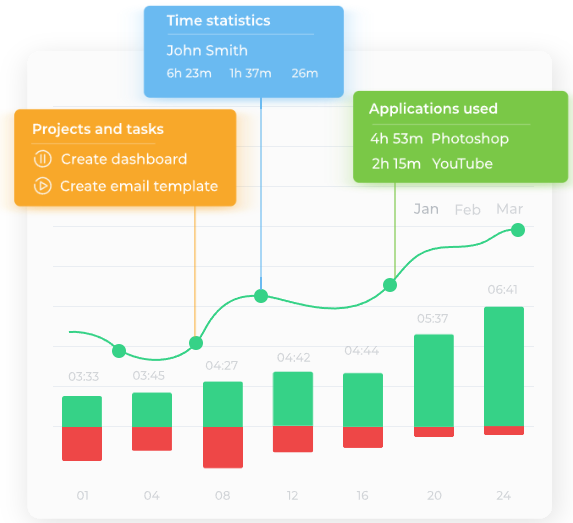Burnout among Gen Z professionals is escalating due to poor work-life balance, inadequate support structures, and unclear boundaries in hybrid or remote work environments. Business leaders must act urgently to prevent long-term productivity loss and talent attrition.
What causes burnout in younger employees in hybrid workplaces?
As of 2024, over 51% of Gen Z employees in the UK report experiencing workplace burnout, according to aggregated research from workforce and mental health surveys. In many cases, burnout begins to manifest within the first two years of employment. This growing concern poses a strategic risk for businesses when considering team continuity, cost of turnover, and long-term engagement. With hybrid work becoming the norm across many organizations, clear lines between personal and professional time have blurred — making time tracking more crucial than ever for performance visibility, team management, and well-being.
These younger professionals — often ambitious but digitally overstimulated — struggle with prolonged screen time, vague performance expectations, and lack of real-time feedback. Many respondents also linked their stress to inconsistent routines and limited connection with managers — all of which compound over time. A reliable employee time tracking strategy doesn’t just support operations; it can give structure to a generation that craves clarity but often lacks it in fragmented digital settings.
The post-lockdown lens: Five years later
Following five years after the UK’s first pandemic lockdown, analysts from workspace broker Click Offices examined burnout indicators affecting Gen Z. They found a significant rise in absenteeism and midweek disengagement among employees under 30. While much of the workforce returned to partial office setups, most Gen Z workers remain in hybrid or remote-first roles — settings that offer autonomy but also isolation.
Interestingly, hybrid arrangements haven't necessarily eased the pressure. Instead, many Gen Z workers operate in a state of permanent ‘informal availability' — checking emails well into personal hours and rarely detaching from work apps. This is where employee time monitoring software becomes essential: it sets boundaries, tracks activity rhythm, and indirectly promotes digital health by revealing when “enough work” really is enough.
How employee time tracking helps prevent occupational fatigue
Structured time management systems are not about surveillance — they are about visibility, consistency, and well-being. Properly implemented tools provide shared reference points: when people start, stop, break, and over-extend themselves. With intelligent interfaces and automated insights into effort allocation, managers are able to proactively detect signs of burnout instead of reacting post-factum to disengaged performance or attrition.

Modern employee time tracking software for business solves two problems simultaneously: it gives leaders accurate data, and gives employees a sense of completion. Knowing when the day is “done” is a surprisingly powerful defense against burnout. It restores control and fosters the psychological safety that’s often lacking in loosely managed virtual environments.
What is employee time tracking software, and why does it matter?
Employee time tracking software is a digital system that records and organizes how individuals spend their work hours. Depending on the solution used, these tools can account for hours worked, breaks taken, tasks accomplished, and even level of engagement across applications. They're invaluable for performance assessment, but more importantly, they champion sustainable productivity by discouraging overwork and enabling fair workload distribution. For businesses, these systems offer traceability and objective management data; for employees — structure, fairness, and often — relief.

What signs indicate burnout among Gen Z professionals?
An alarming pattern among younger team members is inconsistent output despite long digital hours. Gen Z employees tend to internalize pressure to ‘always be available’ — tied to chat apps and asynchronous expectations. Unlike older generations, they fully live in tools like Slack, Teams, and email, and rarely fully unplug. As a result, performance isn’t suffering due to irresponsibility. It's suffering because of invisible overstretching and decision fatigue.
Integrating an employee productivity tracker helps mitigate this by measuring real engagement — not just login times or keystrokes. By using predictive analysis and workload dashboards, team leads can spot when emotional energy is running low, or when extra support is needed on mentally demanding projects. The goal is neither micromanagement nor intrusion, but healthy load-balancing and sustainable output rhythms.
Behavioral signals your team might be burnt out
Here are the five most common workplace behaviors that can signal latent burnout among your younger employees:
- Defensive silence during team check-ins or one-on-one feedback discussions
- Delayed decision-making and dependence on last-minute approvals
- Decline in interpersonal collaboration, fewer Slack or Teams initiations
- Regular overwork followed by sudden absenteeism without reason
- Drop in participation during informal or non-task-related projects
Tracking weekly rhythms through time monitoring platforms can help flag these shifts before they lead to full disengagement or resignation. The earlier a pattern is detected, the lower the cost to correct it.
How can employers proactively reduce burnout risk?
Employers don’t need to overhaul operations to address this issue — but they do need to intentionally create cultures and workflows that respect the boundaries their Gen Z team members aren't always able to enforce on their own. That means equipping managers, adjusting workloads, and integrating tools that normalize healthy routines. More importantly, it implies shifting from “productivity by visibility” toward “productivity by rhythm.”
One proven method is implementing an employee attendance tracking system combined with scheduled performance reviews. Consistency in both monitoring and feedback reduces ambiguity — arguably the No.1 stressor for ambitious but inexperienced colleagues.
4 proven strategies for reversing Gen Z burnout
For leadership teams serious about restoring energy and improving staff retention among newer generations, these targeted actions have shown real impact within mid-sized and scaling firms:
- Establish concrete start-end boundaries using time keeping software with daily alerts
- Balance individual workload heatmaps using employee activity tracking software
- Introduce weekly debriefs to review not just performance goals, but cognitive workload
- Rotate high-focus project roles every two weeks to prevent prolonged repetitive strain
Each step not only reduces burnout risk but also increases employee engagement and longevity by reinforcing meaningful, manageable structure.
Gen Z burnout isn’t just emotional — it’s operational
As businesses scale and new talent enters the workforce, we must acknowledge burnout among Gen Z as more than a temporary HR challenge — it's a reflection of structural inefficiencies in how we manage digital labor. Building clear, accountable frameworks through tools like employee time log systems is one of the most scalable actions a business can take to future-proof both productivity and retention.
Business leaders who prioritize time visibility and operational balance don’t just reduce turnover. They increase creative energy, strategy execution pace, and team adaptability — while sending the message to younger employees: “your time matters, both in and outside of work.”
Looking to protect your team and improve output quality? Start by assessing your current time visibility tools. Introducing structured time-tracking won’t merely optimize processes — it could be the difference between sustained performance and silent burnout.

